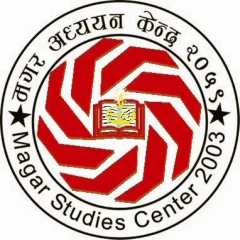Chemjong, Iman S. (2003). History and Culture of Kirat People (Fourth Edition). Lalitpur: Kirat Yakthung Chumlung [First edition 1967]. 1.Annotation by: Dr. Govind Prasad Thapa
The author claims that the “origin of Mangar tribe as mentioned in Kirat chronology is a place in the north called Shin. From there, a group of people under the leadership of two leaders came to the south. The names of the leaders were Shing Mangar and Chitu Mangar. The people of the southern country called them Tangsang Thapa which means the people came from the far away north. Later on, these Mangar tribes multiplied and were divided into 12 groups under twelve leaders and called themselves Barah Mangars. When they came to Sikkim they settled there permanently. They built Jongs or Forts or castles, wherever they settled and called them Mangar Jong or the fort of Mangars or the castle of Mangars. Pandit Sarad Chandra Das has written on the existence of Mangars in Sikkim and Eastern Nepal. The legend which he heard of the Mangar tribe and the ruins of their forts and towns in the valley of Kangbachhan river in the East Nepal is very interesting; people said that ‘the account is correct and true.’” Comparing the language of Magar and Lapcha people, the author claims that there is a close affinity in between them, “There is another proof of the affinity of the Mangar and Lapcha tribe in counting numbers. The Mangar tribe counts one, two, three, four, five as kat, net or nis, sam, buli, banga and the Lapcha tribe says kat, net, sam, fali, fungu. These are the evidences of the residence of Mangar Kirat people in Sikkim. Not only that, but the Mangar chiefs were so active in Sikkim that they kept on fighting with the Sikkimese chiefs up to the 18th century AD. Sikkim history mentions that the Sikkimese chiefs tried their best to bring the Mangar chief under their power by keeping matrimonial connection with them. Chhangzat Karwang, the Chief Minister of Sikkim married the daughter of one of the Mangar chiefs of Sikkim and wanted to keep friendly relation with them, but the Mangars were never influenced by the Buddhist Kings and Ministers of Sikkim. When the Mangar Chief of Sikkim understood that nothing could be expected from the Buddhist King of Sikkim they totally neglected the Sikkimese relation and the Sikkimese also dropped all the records of Mangar people from the history of Sikkim. Still there are many places in Sikkim and East Nepal called Mangar jong or the Fort of Mangar tribe.”
Annotation by: Bishnu Kumar Sinjali
Iman Singh Chemjong is a renowned academician regarding Kirant history, culture and literature. This work is organized in six chapters. The first chapter is related to the term of ‘kirat’ and its origin, history, Mundhum and culture of Kirat etc. Second chapter is related to the revolution of the Kirant people, origin of Limbus and cultures, customary law of Limbus, Limbuwan, etc. The third chapter is related to history and culture of the Kirant people. Fourth chapter is about Gurung, Mangar, Ghale, Pligyi, Kungyi, Sunuwar, Tamang tribes etc. The fifth chapter is also related with history. The author has described about the kingdoms of King Bijaya Narayan Rai of Bijayapur, King Lo hang Sen, Battle of Morang, King Kamadatta sen, King Buddhi karna Rai, Karna Sen, Gorkha Invasion etc. Sixth chapter deals with SikkimGorkha war, Rise and fall of Kocha Kirant people, Meche, Tharu and Rajbansi tribes, Khas-Kirat tribes as Gorkhas or Nepalese Nation etc. The author claims that Magars are Kirat peoples, “The origin of Mangars tribe as mentioned in Kirat chronology is a place in the north called Shin….The people of the southern country called them Tangsang Thapa which means the people came from the far away North. Later on, these Mangar tribes multiplied and were divided into 12 groups..”(p. 138) Author also argues that Magars are composite group of Kirant and Monkhu and later on became Mangar. For this statement he gives the proof of Lepacha Kirat language because they say “Mangorbook or the sweet potato introduced by the Magar. Further, he gives proof of counting system of Magar and Lepacha, then tried include in Kirant people. He is also of the opinion that Magars of Nepal spread from eastern part of Nepal to western part Nepal. His argument is that the existence of Magarjong in Sikkim (Fort of Mangar tribe). Here, there is also mentioned Magar multiple states in western Nepal, tihar is Magar originated festival, history of battle between Sherpas and Magars at Himalaya. He also arguing that Magars are Named due to “Mang or Mong” words gives meaning of Mangoloid people in Chinese and Burmese language and ar = children, that’s why said Mangar.
Chhetri, Subarna; Malla, Suresh (June 2002). Kingdom on Edge, Nepal: Royal Tragedy 2001. Kathmandu: The Hidden Treasure. Annotation by: Gupta Bahadur Rana
In this book, introducing Magars, Nagendra Sharma writes, “The various genealogical charts delineating the family history of the Shah (or Shahi) Dynasty so far available are not in entire agreement, thereby leaving an element of doubt as regards their exact chronology. Quite a few of such charts also seek to connect the earliest Thakuri of Shah Kings with the medieval Rajputs of Chittor in India. But leaving the stories of Shah-Rajput connection aside as being more fanciful than factual, their first ancestors in Nepal litself are said to have been two brothers, Khancha (or Khincha) Khand and Mincha Khand, Kings of Bhirkot, Ridi, Khillum and such other principalities of the far west. Incidentally, some Magar clans of Western Nepal also carry the surname “Khand” till this date, thereby leading some people to presume that there could also be possible Magar streak in Thakuri blood. But, in absence of any corroborative evidence to support this conjecture, it would be premature to conclude this way or the other.”
